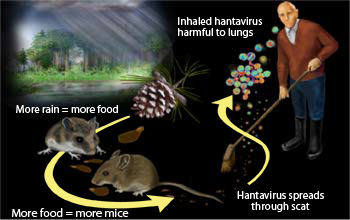All Images
News Release 06-105
Increased Risk of Hantavirus Forecast for U.S. Southwest
Satellite images of ecological conditions help predictions
This material is available primarily for archival purposes. Telephone numbers or other contact information may be out of date; please see current contact information at media contacts.

Contact with rodents and their waste puts humans at risk for exposure to hantavirus.
Credit: Zina Deretsky, National Science Foundation
Download the high-resolution JPG version of the image. (276 KB)
Use your mouse to right-click (Mac users may need to Ctrl-click) the link above and choose the option that will save the file or target to your computer.

The deer mouse (Peromyscus maniculatus) helps spread hantavirus to humans. Its head and body are 2-3 inches long, and the tail adds another 2-3 inches. Its coat varies from gray to reddish brown, depending on the animal's age. Found almost everywhere in North America, the deer mouse likes woodlands but also turns up in desert areas.
Credit: National Park Service photo by John Good
Download the high-resolution JPG version of the image. (85 KB)
Use your mouse to right-click (Mac users may need to Ctrl-click) the link above and choose the option that will save the file or target to your computer.


